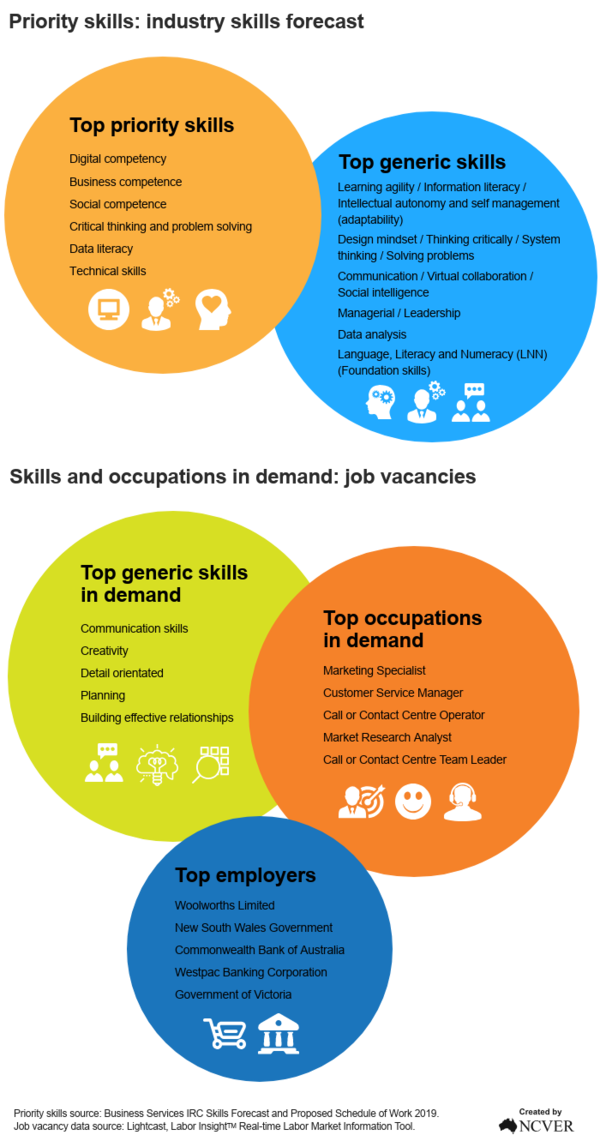National Skills Commission 2022, Occupation Employment Projections viewed 10 August 2022, https://www.nationalskillscommission.gov.au/topics/employment-projections
- by ANZSCO, selected occupations, employment projections to May 2026
- 2251 Advertising and Marketing Professionals
- 1492 Call or Contact Centre and Customer Service Managers
- 5411 Call or Contact Centre Workers.
Australian Bureau of Statistics 2022, 6291.0.55.001 - EQ08 - Employed persons by Occupation unit group of main job (ANZSCO), Sex, State and Territory, August 1986 onwards, viewed 1 August 2022, https://www.abs.gov.au/statistics/labour/employment-and-unemployment/labour-force-australia-detailed/may-2022
- Employed total by ANZSCO 4 digit selected occupations, 2002 to 2022, May Quarter
- 2251 Advertising and Marketing Professionals
- 1492 Call or Contact Centre and Customer Service Managers
- 5411 Call or Contact Centre Workers.
Training data has been extracted from the National VET Provider Collection, Total VET Students and Courses from the following training package or qualifications:
- BSA Administration and BSB Business Services Training Packages
- Advertising
- BSB40107 - Certificate IV in Advertising
- BSB40115 - Certificate IV in Advertising
- BSB40601 - Certificate IV in Business (Advertising)
- BSB50107 - Diploma of Advertising
- BSB50115 - Diploma of Advertising
- BSB60107 - Advanced Diploma of Advertising
- BSB60110 - Advanced Diploma of Advertising
- BSB60115 - Advanced Diploma of Advertising
- Customer Engagement
- BSB20207 - Certificate II in Customer Contact
- BSB20211 - Certificate II in Customer Contact
- BSB20215 - Certificate II in Customer Engagement
- BSB30207 - Certificate III in Customer Contact
- BSB30211 - Certificate III in Customer Contact
- BSB30215 - Certificate III in Customer Engagement
- BSB40307 - Certificate IV in Customer Contact
- BSB40311 - Certificate IV in Customer Contact
- BSB40312 - Certificate IV in Customer Contact
- BSB40315 - Certificate IV in Customer Engagement
- BSB50307 - Diploma of Customer Contact
- BSB50311 - Diploma of Customer Contact
- BSB50315 - Diploma of Customer Engagement
- Marketing and Communication
- BSB40701 - Certificate IV in Business (Marketing)
- BSB40820 - Certificate IV in Marketing and Communication
- BSB41307 - Certificate IV in Marketing
- BSB41315 - Certificate IV in Marketing
- BSB42415 - Certificate IV in Marketing and Communication
- BSB50620 - Diploma of Marketing and Communication
- BSB50701 - Diploma of Business (Marketing)
- BSB51207 - Diploma of Marketing
- BSB51215 - Diploma of Marketing
- BSB52415 - Diploma of Marketing and Communication
- BSB60507 - Advanced Diploma of Marketing
- BSB60515 - Advanced Diploma of Marketing
- BSB60520 - Advanced Diploma of Marketing and Communication
- BSB61315 - Advanced Diploma of Marketing and Communication.
This includes superseded qualifications and training packages.
Data covers a range of selected student and training characteristics in the following categories and years:
- 2017 to 2021 program enrolments
- 2017 to 2021 program completions
- 2021 subject enrolments
Total VET students and courses data is reported for the calendar year. Program enrolments are the qualifications, courses and skill-sets in which students are enrolled in a given period. For students enrolled in multiple programs, all programs are counted. Program completion indicates that a student has completed a structured and integrated program of education or training. Location data uses student residence. Subject enrolment is registration of a student at a training delivery location for the purpose of undertaking a module, unit of competency or subject. For more information on the terms and definitions, please refer to the Total VET students and courses: terms and definitions document.
Low counts (less than 5) are not reported to protect client confidentiality.
Percentages are rounded to one decimal place. This can lead to situations where the total sum of proportions in a chart may not add up to exactly 100%.
BSA – Administration and BSB – Business Services Training Packages apprentice and trainee data has been extracted from the National Apprentice and Trainee Collection, including:
- 2012 to 2021 commencements
- 2012 to 2021 completions
- apprentices and trainees in-training October to December 2021 collection, by qualification and state and territory of data submitter.
Job vacancy data have been extracted from Lightcast 2022, Labor Insight Real-time Labor Market Information Tool, Boston, viewed August 2022, https://lightcast.io/apac.
Data shown represent most requested generic skills, occupations and employers according to internet job postings in Australia between July 2019 and June 2022 filtered by ANZSIC and ANZSCO classification levels listed below. ANZSCO occupations have been used as industry filters because they provide more relevant job vacancy data for this sector.
- Generic skills/Occupations
- 2251 Advertising and Marketing Professionals
- 1492 Call or Contact Centre and Customer Service Managers
- 5411 Call or Contact Centre Workers.
- Employers
- 225113 Marketing Specialist
- 149212 Customer Service Manager
- 541112 Call or Contact Centre Operator
- 225112 Market Research Analyst
- 541111 Call or Contact Centre Team Leader.

